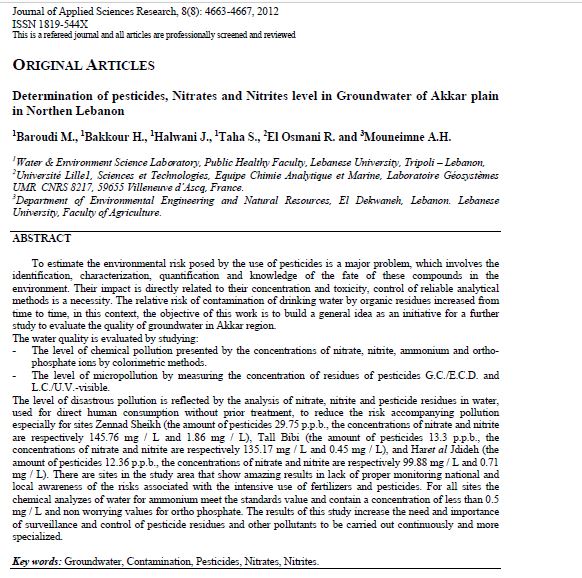Determination of pesticides, Nitrates and Nitrites level in Groundwater of Akkar plain in Northen Lebanon
 |
thèse Jan 2012
Ed. LU - Beirut
Téléchargeable sous format: PdF
Abstract:
To estimate the environmental risk posed by the use of pesticides is a major problem, which involves the
identification, characterization, quantification and knowledge of the fate of these compounds in the
environment. Their impact is directly related to their concentration and toxicity, control of reliable analytical
methods is a necessity. The relative risk of contamination of drinking water by organic residues increased from time to time, in this context, the objective of this work is to build a general idea as an initiative for a further
study to evaluate the quality of groundwater in Akkar region.
The water quality is evaluated by studying:
- The level of chemical pollution presented by the concentrations of nitrate, nitrite, ammonium and orthophosphate
ions by colorimetric methods.
- The level of micropollution by measuring the concentration of residues of pesticides G.C./E.C.D. and
L.C./U.V.-visible.
The level of disastrous pollution is reflected by the analysis of nitrate, nitrite and pesticide residues in water, used for direct human consumption without prior treatment, to reduce the risk accompanying pollution especially for sites Zennad Sheikh (the amount of pesticides 29.75 p.p.b., the concentrations of nitrate and nitrite are respectively 145.76 mg / L and 1.86 mg / L), Tall Bibi (the amount of pesticides 13.3 p.p.b., the concentrations of nitrate and nitrite are respectively 135.17 mg / L and 0.45 mg / L), and Haret al Jdideh (the amount of pesticides 12.36 p.p.b., the concentrations of nitrate and nitrite are respectively 99.88 mg / L and 0.71 mg / L). There are sites in the study area that show amazing results in lack of proper monitoring national and local awareness of the risks associated with the intensive use of fertilizers and pesticides. For all sites the chemical analyzes of water for ammonium meet the standards value and contain a concentration of less than 0.5 mg / L and non worrying values for ortho phosphate. The results of this study increase the need and importance of surveillance and control of pesticide residues and other pollutants to be carried out continuously and more specialized.
Public-Cible:
Pays concerné: |
Editeur/Diffuseur: |
|
LU
-
Université Libanaise - Beirut - Liban |
En cas de lien brisé, nous le mentionner à communication@pseau.org